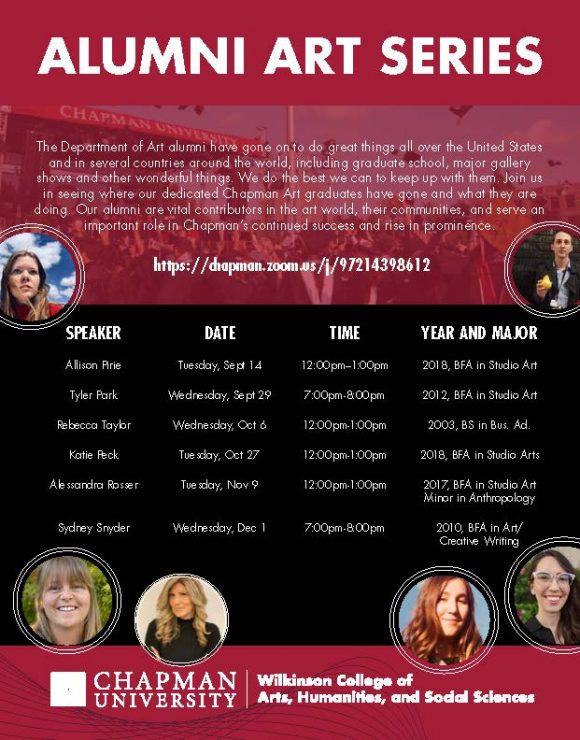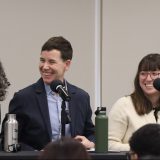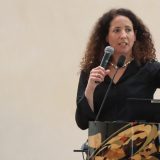
Career Corner Successful Artist Alumni
September 27, 2021

Erin Berthon, MA Career Advisor, Wilkinson College of Arts, Humanities, and Social Sciences, at Chapman University
Throughout the fall semester, Wilkinson College of Arts, Humanities, and Social Sciences is hosting a virtual series featuring several alumni from the Department of Art that offers students insight into each alum’s individual journey to becoming successful in their art career. I spoke to a few of the upcoming presenters to hear how the Department of Art provides students of visual art, graphic design, and art history majors with a comprehensive liberal arts education that equips them for lifelong success in their artistic practice.
Tyler Park, (BFA in Studio Art, 2012) began interning at an art gallery during his undergraduate education. For Park, the experience “opened his eyes to a different career path” that he was not previously aware of and led him to open his own art gallery in Los Angeles called Tyler Park Presents.
There is a wide variety of career paths accessible to students with an art degree. The skill sets developed in undergraduate artistic education can prepare students for success in jobs such as art director, fine artist, gallery manager, illustrator, exhibition designer, graphic designer, animator, and more (AGCAS).
Undergraduate art education does not only advance a student’s artistic talents, but it develops their soft skills in areas like interpersonal communication, critical thinking, and the ability to work productively alone and in a group (Patterson). A student’s creativity is also nourished by art education. According to a 2010 IBM survey of 1,500 chief executive officers from 60 countries and 33 industries, creativity was designated as by far the most crucial leadership quality. The abilities students acquire from their art education are applicable to multiple professions, and as such an art degree prepares students for success in whichever path they choose.
The U.S. Bureau of Labor Statistics reported in 2019 that the median annual salary for craft and fine artists was $48,760 and $52,110 for graphic designers. While it is attainable for most artists to reach this middle-class worker status, there are higher-paying job opportunities in the creative field. Art directors, who manage the visual style of everything from written publications to product packaging to movie and television productions, were reported in 2019 to earn a median wage of $97,270 annually (U.S. Bureau of Labor Statistics). There is no data on the median income of freelance creatives, but this does not negate the fact that it is possible to commercialize the artistic work that you enjoy.
Katie Peck (BFA in Fine and Studio Arts, 2018) has hosted and contributed to several solo and group shows, and given multiple public lectures about her work,  which centers around plastic pollution, consumption, and protecting local waterways. Peck says classes like Contemporary Curatorial Practices gave her a head start into the art world because they offered her experience meeting with art curators, dealers, and collectors. She accredits her education for having trained her on “how to curate a dynamic, inclusive, and professional art show,” enabling her to create the work she does today.
which centers around plastic pollution, consumption, and protecting local waterways. Peck says classes like Contemporary Curatorial Practices gave her a head start into the art world because they offered her experience meeting with art curators, dealers, and collectors. She accredits her education for having trained her on “how to curate a dynamic, inclusive, and professional art show,” enabling her to create the work she does today.
Alessandra Rosser, (BFA, 2017), contends that the key to becoming successful in the art world is “time, effort, and passion.” Rosser committed herself to her artistic passion during her years at Chapman, forming relationships with professors, interning at the on-campus art gallery, studying abroad, and devoting herself to her coursework. Today, she is the director of operations at an art gallery called ArtMovement L.A. She advises that “what you put in, you always get out.”
It may take time to develop a sustainable freelance art career, but if pursuing your passion for art means sacrificing the easier option, it will be worth it. A 2013 study within a large-scale social research project called the European Values Study, investigated the job satisfaction of various career persons in 49 different countries. On average, artists reported higher satisfaction with their work than non-artists (Bille, et. al). The study reported that the autonomy an artistic career contributes to a happier lifestyle. Freelance artists especially are free to control the number of hours they work and the type of projects they take on, allowing them to devote time to the work that they love. A career in art is a viable option, especially if you have a passion for it because you will likely be happier creating your art than working a job that you do not love.
The film “Dead Poets Society” adequately validates the choice to pursue one’s love for art. As Robin Williams’ character states, “Medicine, law, business, engineering, these are noble pursuits, and necessary to sustain life. But poetry, beauty, romance, love, these are what we stay alive for.”
Wilkinson College’s Department of Art alumni series meetings can be attended here: https://chapman.zoom.us/j/97214398612
- Sept 14: Allison Pirie (’18, BFA Studio Art), 12 – 1 p.m.
- Sept 29: Tyler Park (‘12, BFA in Studio Art), 7 – 8 p.m.
- Oct 6: Rebecca Taylor (’03, BS Business Administration), 7 p.m. – 8 p.m.
- Oct. 27: Katie Peck (’18, BFA in Studio Art), 12 – 1 p.m.
- Nov. 9: Alessandra Rosser (’17, BFA in Studio Art Minor), 12 p.m. – 1 p.m.
- Dec. 1, 2021: Sydney Snyder (’10, BFA Art), 7 p.m. – 8 p.m.
Join us and learn how to pursue a career in the art world!

